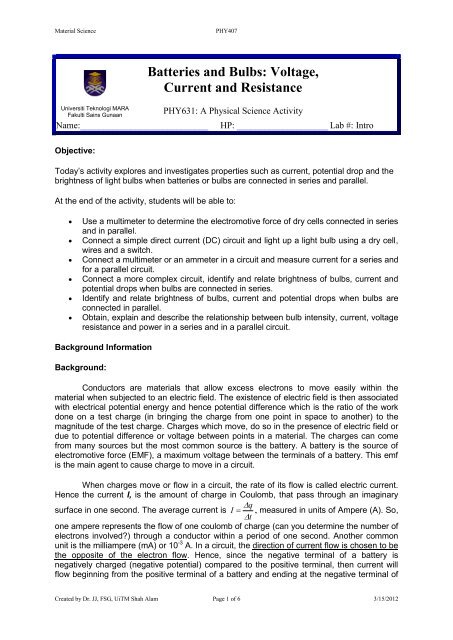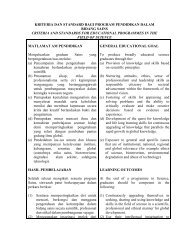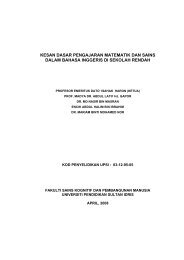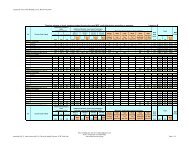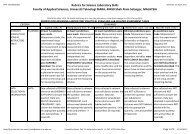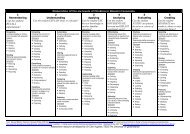Create successful ePaper yourself
Turn your PDF publications into a flip-book with our unique Google optimized e-Paper software.
Material SciencePHY407Universiti Teknologi MARAFakulti Sains GunaanName:____________________________Batteries and Bulbs: Voltage,Current and Resistance<strong>PHY631</strong>: A Physical Science ActivityHP: ____________________ Lab #: <strong>Intro</strong>Objective:Today’s activity explores and investigates properties such as current, potential drop and thebrightness of light bulbs when batteries or bulbs are connected in series and parallel.At the end of the activity, students will be able to:Use a multimeter to determine the electromotive force of dry cells connected in seriesand in parallel.Connect a simple direct current (DC) circuit and light up a light bulb using a dry cell,wires and a switch.Connect a multimeter or an ammeter in a circuit and measure current for a series andfor a parallel circuit.Connect a more complex circuit, identify and relate brightness of bulbs, current andpotential drops when bulbs are connected in series.Identify and relate brightness of bulbs, current and potential drops when bulbs areconnected in parallel.Obtain, explain and describe the relationship between bulb intensity, current, voltageresistance and power in a series and in a parallel circuit.Background InformationBackground:Conductors are materials that allow excess electrons to move easily within thematerial when subjected to an electric field. The existence of electric field is then associatedwith electrical potential energy and hence potential difference which is the ratio of the workdone on a test charge (in bringing the charge from one point in space to another) to themagnitude of the test charge. Charges which move, do so in the presence of electric field ordue to potential difference or voltage between points in a material. The charges can comefrom many sources but the most common source is the battery. A battery is the source ofelectromotive force (EMF), a maximum voltage between the terminals of a battery. This emfis the main agent to cause charge to move in a circuit.When charges move or flow in a circuit, the rate of its flow is called electric current.Hence the current I, is the amount of charge in Coulomb, that pass through an imaginaryqsurface in one second. The average current is I , measured in units of Ampere (A). So,tone ampere represents the flow of one coulomb of charge (can you determine the number ofelectrons involved?) through a conductor within a period of one second. Another commonunit is the milliampere (mA) or 10 -3 A. In a circuit, the direction of current flow is chosen to bethe opposite of the electron flow. Hence, since the negative terminal of a battery isnegatively charged (negative potential) compared to the positive terminal, then current willflow beginning from the positive terminal of a battery and ending at the negative terminal ofCreated by Dr. JJ, FSG, <strong>UiTM</strong> Shah Alam Page 1 of 6 3/15/2012
Material SciencePHY407the battery if there are conducting wires between the terminals. Often, a load or a resistor isplaced between the terminals. If the resistor is a bulb, the bulb may light up when currentflows through it. The strength to resist the flow of current in a resistor is called resistance, R,measured in units of Ohms () and its value depends only on the geometry of the resistoritself such as the type of conductor (element), its length and its surface area. Resistors ordevices which have a linear relationship between voltage and current obey Ohm’s Law.Current in a circuit can be measured by using an ammeter which must be connectedby breaking up a point in the circuit. This type of connection is usually referred to as a seriesconnection. In addition, since charges (electrons) move between points in a circuit under theinfluence of the battery’s emf, then potential difference exist between points in the circuit.This potential difference, (measured in volts (V)), can be measured by using a voltmeter andis done by touching the probes of the voltmeter across the points of interest in the circuit.This type of connection is referred to as parallel connection. Light bulbs in a circuit light upwith different brightness depending on the average power it consumes. For any device, itsaverage power is the product of the current through it and the voltage across it, P IV . Thehigher the intensity (brightness) of a bulb, the higher is the average power.Student ActivityInvestigation 1-Lighting a Bulb(DO YOUR PREDICTION BEFORE STARTING THE ACTIVITIES)Prediction 1.1: (Batteries shown in the figure below are each 1.5 V battery)i) What will the voltmeter reading be if the probes are connected between pointsA and B? Will it change if the probe of the voltmeter is reversed?ii) Would the reading change if the probes are placed between points B and C,and between A and C?iii) What would the reading be if the positive terminals are connected together inan antiseries connectionActivity 1.1:Observe the batteries and identify the positive and negative terminal. Using amultimeter with the dial set at DC, place the probes at points A and B respectively foreach of the case above and record the reading. You may need to change the dial onthe meter to get the best reading.Repeat the above for points B and C and points A and C. Then reverse the probesstarting with points B and A, C and B, and C and A. Record you reading and tabulatethe data.Created by Dr. JJ, FSG, <strong>UiTM</strong> Shah Alam Page 2 of 6 3/15/2012
Battery 6 VMaterial SciencePHY407iii) Connect an ammeter tomeasure the current that flowsthrough the circuit. Record yourreading. Note that an ammeterMUST be connected in serieswith the bulb (You must breakthe circuit connection in order foryou to insert the ammeter).BAmAiv) Add another bulb in the circuit,observe the brightness of thebulbs and repeat steps (ii) and(iii).v) Add yet another bulb in thecircuit, observe the brightness ofthe bulbs and repeat steps (ii)and (iii).BS 1ALABVBrightness AB V bulb-1 V bulb-2 V bulb-3Bulbs in SeriesV V V VBulb 1 none noneBulb 1 + Bulb 2noneBulb 1 + Bulb 2 +Bulb 3AI ABAPowerWattsv) Unscrew any bulb and observe what happens to the bulbs and to the currentin the circuit. Record your observation.Questions1. What causes the bulb to light up when the switch is thrown down?2. Why did the bulb go off when it is unscrewed from the holder?3. Did it matter if the polarity of the bulb is reversed? Why or why not?4. Why is the voltage the same when measured across the battery or across thebulb for a single circuit?5. What is the physical meaning of the current reading on the ammeter?6. What happens to the brightness of the first bulb, the voltage across it and thecurrent in the circuit when a second bulb is added in series to the circuit?7. What happens to the brightness of the first bulb, the voltage across it and thecurrent in the circuit when a third bulb is added in series to the circuit?8. Can you propose a model on how the brightness of the bulbs change as thenumber of bulbs are increased or decreased in a series circuit?9. Is there a relationship between the number of bulbs and the current in acircuit?10. How can this brightness model be related to the electrical power?11. What happens to the current in the circuit when any one of the bulbs isunscrewed? Explain.Created by Dr. JJ, FSG, <strong>UiTM</strong> Shah Alam Page 4 of 6 3/15/2012
Battery 1.5 VMaterial SciencePHY407Investigation 2 - Bulbs in ParallelPrediction 2.1: (The battery shown in the figure below is a 1.5 V battery)i) Will all the bulbs in the parallel circuit have the same brightness?ii) What will the voltmeter reading be if the probes are connected between pointsA and B and between C and D respectively for the bulbs connected iniii)parallel?S 1Would the BADFHchange if thevoltage readingS 2S 3S 4probes areplaced across theterminals of theR 1R 2R 3second bulb(between E andF), and acrossthe terminals ofthe third bulb A(between G andH)?CEGiv) Would you consider the contact points at point B, D, F and point H to be anequipotential point?v) Will the current going through the circuit the same as the current through thefirst bulb, the second bulb or the third bulb?vi) What will happen to the brightness if one bulb is unscrewed, if 2 bulbs areunscrewed? What happens to the current in the circuit?A1A2A3Activity 2.1:i) Connect the bulbs in parallel as shown in the figure but start with 2 bulbsfollowed by three bulbs. Observe the brightness of the bulbs as more bulbsare added in parallel. Then, using a multimeter with the dial set on DC mode,measure the voltage across the battery, V AB , the voltage across the first bulb,V CD , the voltage across the second bulb, V EF , and the voltage across the thirdbulb, V GH . Record your reading.LABBulbs in parallelV ABVV CDVV EFVV GHVBulb 1 none noneBulb 1 + Bulb 2noneBulb 1 + Bulb 2+ bulb 3Created by Dr. JJ, FSG, <strong>UiTM</strong> Shah Alam Page 5 of 6 3/15/2012
Material SciencePHY407ii)Now place an ammeter between points B and D. Record your reading. Thenplace an ammeter between points C and D and also between points E and Fand between G and H. Record your reading.LABBulbs inparallelI ABABulb 1 none none noneBulb 1 + Bulbnone2Bulb 1 + Bulb2 + bulb 3I CDAI EFAI GHAPowerWattsiii)iv)Unscrew the first bulb Observe the brightness of the remaining bulbs andwrite your observation. Then record all the ammeter readings.Unscrew the second bulb leaving only the third bulb in the circuit. Observe thebrightness of the remaining bulb and write your observation. Then record allthe ammeter readings.LABBulb 1unscrewedBulbs 1 & 2unscrewedI ABAI CDAI EFAI GHAPowerWattsQuestions1. What happens to the brightness of the first bulb and the current through itwhen a second bulb is added in parallel to the circuit? What about the power?2. What happens to the brightness of the first bulb and the current through itwhen a third bulb is added in parallel to the circuit? What about its power?3. Is there a relationship between the number of bulbs and the total current in acircuit?4. Can you propose a model on how the brightness of the bulbs change as thenumber of bulbs are increased or decreased in a parallel circuit? What abouta model for the power?5. What happens to the current in the circuit when any one of the bulbs isunscrewed? What about its power?6. What happens to the total voltage and the voltages across the bulbs as morebulbs are added?7. What happens to the total current as more bulbs are added?8. What happens to the total power as more bulbs are added?Created by Dr. JJ, FSG, <strong>UiTM</strong> Shah Alam Page 6 of 6 3/15/2012


